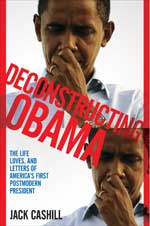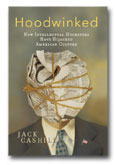Benghazi Narrative Shift
Was Perfectly Clintonian
Get your copy of Deconstructing Obama

___
Jack Cashill's book:
Hoodwinked: How Intellectual Hucksters have Hijacked American Culture

Click here for signed first edition
©Jack Cashill
AmericanThinker.com - May 17, 2013
BalfourPost.com - May 18, 2013
“We’ve seen rage and violence directed at American embassies over an awful Internet video that we had nothing do to with,” said Hillary Clinton to the families of the four Americans killed at Benghazi and others gathered at a September 2012 memorial service.
Her boss, President Barack Obama, had been reciting the same lie in one forum after another in the days following the September 11 attack on the American outpost in Benghazi. To give the lie credence, his Justice Department immured the producer of the video, a Coptic Christian named Nakoula Basseley Nakoula, in a West Texas prison.
Obama appeared to be taking his cues from the Clinton playbook, improvised in their desperate effort to retain the White House after the electoral debacle of November 1994: Shift the narrative, ridicule the critics, bury the truth tellers.
To pull this off, the Clintons would be called upon to shift the narrative no fewer than five times in the two utterly corrupt years before the 1996 election. The media, dismayed by the Newt Gingrich ascendancy, fully enabled them.
Oklahoma City, April 19, 1995.
Twenty minutes before the blast that leveled the Murrah Federal building in downtown Oklahoma City employees at a tire store spotted Timothy McVeigh and a short Mid Eastern-looking man in a Ryder truck and gave the pair directions.
Five minutes before the blast, printing operator Jerry Nance noticed an unusual car in the downtown Oklahoma City parking lot. It was a dilapidated yellow Mercury Marquis. Behind the wheel was a dark-skinned, Middle Eastern-looking man in a ball cap.
When Nance walked back towards the car to get some stuff from his own car, the Mercury Marquis almost ran him over. Now, however, the Middle Eastern man was sitting in the passenger seat, and a tall white man was driving the car out of the parking lot, recklessly at that.
Two minutes later, the Murrah building blew up. Nance informed the FBI of this incident and the car before anyone knew McVeigh had been apprehended in a yellow Mercury Marquis.
Another eyewitness, Daina Bradley, cried out to the rescuers who were trying to extricate her after the blast. “It was a Ryder truck. It pulled up, a foreign looking man got out, and then before long, everything went black.”
A week later, the FBI quoted Nance and the tire store employees in its request before a federal judge to hold McVeigh over for trial. The Washington Post of April 28 confirmed the same:
The magistrate, Ronald L. Howland, ordered McVeigh to be held without bail after listening to four hours of testimony from FBI special agent John Hersley in which he described eyewitness accounts of a yellow Mercury with McVeigh and another man inside speeding away from a parking lot near the federal building. (italics mine)
For the next six weeks, John Doe #2 was the most hunted man in the world until, without explanation, he just kind of went away. The narrative had shifted. The White House only needed the two white right-wingers, Terry Nichols and McVeigh. With them as poster children, the media buried Gingrich’s “Republican Revolution” in the rubble of the Murrah building.
Dubrovnik, April 3, 1996.
Not one to shy from exploitation of a tragedy, President Bill Clinton profaned the memory of Martin Luther King—who had been killed on April 4, 1968—by comparing King’s mission to that of his Commerce Secretary Ron Brown who had died the day before when he and 34 others on a USAF plane crashed into a Croatian hillside.
What Clinton did not say was that Brown had gone to Croatia to broker a sweetheart deal between the neo-fascist strongman who ran Croatia, Franjo Tudjman, and the Enron Corporation. This was all part of the Clintons’ desperate drive to raise money for their 1996 reelection campaign.
Brown’s flight left from Tuzla in Bosnia, a Muslim country swarming with mujahideen. This flight came just six months after the Dayton Accords and nine days after Hillary Clinton deviated from her European tour to visit Tuzla (where, by the way, she was buzzed by that apocryphal “sniper fire.”)
The narrative, however, could not even hint at terror. “Brown’s entourage boarded an Air Force T-43 for the coastal town of Dubrovnik,” asserted a Time magazine reporter following the White House’s lead on the cause of the crash, “where one of the worst storms in a decade was raging.”
In reality, when Brown’s plane approached Dubrovnik, it was not raining, and the sun was peaking through the clouds. The Enron executives had taken their own plane and landed safely minutes earlier.
For the first time ever on friendly soil, the White House ordered the Air Force to skip the “safety” phase of the investigation and move directly to the “accident” phase. There was to be no consideration other than accident, even though this airport was near the Bosnian border and in a potential hot fire zone.
The Air Force called the pilot’s nearly two-mile deviation into a Croatian hillside “inexplicable.” No aircraft had ever drifted inland before at that airport. The AWACS data suggested sabotage of the ground-based navigation system, a line of inquiry that the Air Force was not allowed to pursue.
Three days after the crash and two days before his scheduled interview by the Air Force, the Croatian responsible for the airport’s navigation system was found with a bullet hole in his chest. The Tudjmans called it a suicide.
A day later, every pathologist who viewed Brown’s body concluded that his head wound, at the very least, looked like a bullet hole. In a decision that reached the White House, there was to be no autopsy. The Brown family was not informed. Nor was there any forensic testing or a search for an exit wound.
The Clintons did not want to know the truth about Ron Brown’s death, and they certainly did not want to share it. They used a reluctant Air Force and a nearly mutinous Armed Forces Institute of Pathology to bury Ron Brown as quickly as possible, literally and figuratively.
The three Armed Forces pathologists and the forensic photographer who blew the whistle on this case got to play the “Nakoula” role—they were dispatched to career-killing dead end jobs.
The fate of Brown confidante and whistleblower, Nolanda Butler Hill, was more unpleasant still. After testifying at a hearing on matters related to Brown , Hill had her lawyer talk to then Deputy Attorne y General Eric Holder . She feared the worst and hoped to head it off.
Holder, however, was not sympathetic. He told Hill’s lawyer that her statements “were getting her into trouble.” “Trouble,” in this case, eventually meant a year in hiding and imprisonment on a bogus tax charge, also in Texas.
On April 14, four days after Brown’s funeral, Clinton watched in shock as his buddy Greg Norman blew a six-stroke lead in the final round of the Masters, the greatest choke in the tournament’s history.
“Yes,” Clinton told press aide, Mike McCurry, “that’s going to be the new theme for the campaign, that we’re not going to allow ourselves to be Greg Normanized.” Clinton was horrified in a way few around him could understand. “We could have a major crisis go bad on us,” he fretted constantly. “Greg Norman,” he repeated to his staff. “Greg Norman.”
Saudi Arabia, June 25, 1996.
Throughout the 1996 election cycle Clinton adviser Dick Morris did not shy from telling the president that despite the lead he scrambled to gain in his contest against Bob Dole, he had “a soft underbelly,” namely that the majority of the voters did not particularly trust or respect him.
Morris was worried that a terrorist act could expose that underbelly in the months leading up to the November election. In June and July of that year the White House had to deal with “three attacks” in what Morris referred to as “the terror summer of 1996.”
On June 25, 1996, a powerful truck bomb exploded outside a US army barracks, the Khobar Towers in Saudi Arabia. It killed nineteen American serviceman and wounding hundreds more.
This was undeniably Islamic terrorism. The tough talking President Bill Clinton promised revenge. "The cowards who committed this murderous act must not go unpunished," he said angrily. "Let me say again: We will pursue this. America takes care of our own. Those who did it must not go unpunished."
Well, maybe, maybe not. While Clinton was talking tough, Dick Morris was busily conducting polls to gauge the public's reaction. "Whenever there was a crisis, I ordered an immediate poll," Morris would later write. "I was concerned about how Clinton looked in the face of [the attack] and whether people blamed him." It was Greg Norman time at the White House.
Morris's first poll showed less support for Clinton than he had hoped. But after a good deal of Clintonian bluster, public approval of Clinton's response climbed. Morris recorded this in his written agenda for a meeting:
SAUDI BOMBING —
Recovered from Friday and looking great
Approve Clinton handling 73-20
Big gain from 63-20 on Friday
Security was adequate 52-40
Bottom line:
It's not Clinton's fault 76-18
With the political fallout contained, Clinton handed this case off to law enforcement just as he did after the first World Trade Center bombing. But this time, the Clinton administration not only failed to follow useful leads, but it also impeded the investigators. Sound familiar?
So frustrated was FBI head Louis Freeh by Clinton’s obstruction that he asked former president George H. W. Bush to intercede with the Saudi royal family. Bush did, and this new information pointed to Iran as the Clintons suspected it would from day one.
Still, Freeh never got the support he wanted from the Clinton White House. He hung on to his job to 2001 largely to prosecute this case. Just before Freeh left office, in June 2001, attorney general John Ashcroft announced the indictment of fourteen of the terrorists—five years after the fact.
Long Island, New York, July 17, 1996.
On this pleasant summer evening, Liberation Day in Saddam’s Iraq and two days before the start of the Atlanta Olympics, hundreds of people saw streaking objects zigzag off the horizon and culminate in the destruction of TWA Flight 800 off the south coast of Long Island.
At the time of the crash Clinton sycophant Richard Clarke was serving as chairman of the Coordinating Security Group on terrorism (CSG). Within thirty minutes of the plane’s crash, Clarke would later write, he convened a meeting of the CSG in the White House situation room, the first time ever for a plane crash.
“The FAA,” Clarke reported, was “at a total loss for an explanation.” In fact, the FAA did have an explanation. Its radar operators in New York saw on their screens an unknown object “merging” with TWA 800 in the seconds before the crash and rushed the radar data to Washington.
By mid-August, the FBI had interviewed some 270 people who saw what appeared a missile or missiles attack the plane. This information they did not share with the Times, but they did share with analysts from the Defense Intelligence Agency’s Missile and Space Intelligence Center, who re-interviewed 34 of the eyewitnesses.
Throughout August, the FBI was telling the New York Times that explosive residue had been found throughout the plane and especially along the right wing. Plus, the FBI’s Washington lab had identified the residue as PETN, a component of either missiles or bombs.
The same Times article called the finding “a serious blow to the already remote possibility that a mechanical accident caused the crash.” On August 23, the New York Times broke a headline story, top right, above the fold—“Prime Evidence Found That Device Exploded in Cabin of Flight 800.”
This article stole the thunder from Clinton’s election-driven approval of welfare reform in that same day’s paper and threatened to undermine the whole peace and prosperity mantra of the Democratic convention just days away. Time for a shift in the narrative.
At about this time, Clarke alleged to have visited the site of the TWA 800 investigation on Long Island. There he casually stopped to talk to a technician, who shared with him the astounding fact that, despite all evidence to the contrary, an exploding fuel tank destroyed TWA Flight 800.
That same day, according to Clarke, he returned to Washington and breathlessly shared his exploding fuel tank theory with chief of staff Leon Panetta and NSA director Tony Lake, even sketching the 747 design.
“Does the NTSB agree with you,” Lake asked Clarke.
“Not yet,” said Clarke. In one chance stroll through the hangar, the amateur Clarke discovered something that the FBI or NTSB has not yet discovered itself. Clarke then added the telling comment, “We were all cautiously encouraged.” They were “encouraged” because the political people did not want to face the consequences of terrorism. It could derail their cakewalk to reelection.
From this point on, the administration spent all its energies making Clarke’s exploding fuel tank theory stick. The FBI was forced to change its story, and so did The New York Times. When former U.S. Senator Pierre Salinger challenged the White House narrative, the media ridiculed him. When investigative reporter James Sanders undid that narrative, the Justice Department had him and his wife Elizabeth arrested for conspiracy to steal airplane parts. The media remained silent.
Atlanta, July 27, 1996.
The very same day that the Clintons went to Long Island to meet with the TWA Flight 800 families, security guard Richard Jewell was patrolling the grounds of Centennial Park in Atlanta.
Right around midnight Jewell spotted a large, olive-green, military-style backpack, known as an Alice pack, under a bench. He immediately shared this information with the Georgia Bureau of Investigation. When the GBI could not find the pack’s owner, the GBI officer and Jewell began to clear an area around the pack.
Soon afterwards, the pack exploded. Two people died and more than a hundred were injured. If this sophisticated 40-pound bomb had not been jostled, and had Jewell not seen it, the bomb might have killed hundreds.
Richard Clarke and the Clinton administration were understandably worried about terrorism, but in the “feel good” Olympic games of 1996, in the lead up to the Clinton re-nomination, no official even speculated as to whether Islamic terrorists might be behind the Olympic bombing.
Rather than alarm the Olympic-goers and the nation with the possibility of a widespread terror plot, the Clinton Justice Department suppressed information about other bombs that had been defused and blamed the one lethal blast on the transparently innocent Jewell. Its agents then hounded Jewell all the way through the end of October.
Eventually, the bomb would be traced to a crazed anti-abortion activist named Eric Rudolph. The Clintons would have loved to know this in July 1996, but Richard Jewell sufficed.
One final irony. Towards the end of the 1996 campaign the media started challenging Clinton about the illegal Asian money he had been using to fund his campaign. To suggest his own innocence, and the media’s recklessness in accusing him, Clinton compares himself to, yes, Richard Jewell.
And he got away with it. That’s how easy it was to shift the narrative when you had an Internet still in its embryo stage, no Fox News, a fully compliant media, a president who could lie much better than the current one, and a nearly universal belief that anyone who sought the truth was a “conspiracy theorist.”
Webmaster's Note: Jack Cashill's Book-TV presentation of "Deconstructing Obama" can be viewed at http://www.c-spanvideo.org/program/298382-1
 Webmaster's Further Note: In this stunning, surprisingly entertaining, 90 minute, one-man tour de
force Jack Cashill traces the roots of September 11 to the perfect storm
of disinformation that surrounded the Clintons' desperate drive for the
White House in the years '95-'96
Webmaster's Further Note: In this stunning, surprisingly entertaining, 90 minute, one-man tour de
force Jack Cashill traces the roots of September 11 to the perfect storm
of disinformation that surrounded the Clintons' desperate drive for the
White House in the years '95-'96
Click on image to order your video.
Editor's note: For a more complete account of this phenomenon, read Jack Cashill's amazing book, "Hoodwinked: How Intellectual Hucksters Have Hijacked American Culture.

